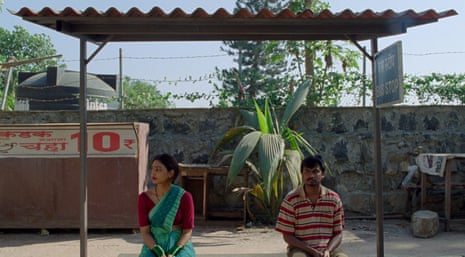By William Blick.
Hysterical, soul-stirring, and bewildering…undefinable in the best sense of the word.”
Occasionally, I will see a film wherein I do not know where it will lead me. It is at this time that there is often a leap of faith in putting my trust in the hands of an unknown director. This has often led to some of the most rewarding cinematic experiences that I can recall. One such experience was the hysterical, soul-stirring, and bewildering Sister Midnight (2024), written and directed by Karan Kandhari and undefinable in the best sense of the word.
Opening with a tracking shot of railroad trestles and pulling back to reveal the Indian landscape, Kandhari chooses to contrast the visuals with a soundtrack of the American blues legend, Howlin’ Wolf. In these opening frames, one can already tell that this is a film that will defy easy classification.
Sister Midnight has a bizarre, wry sense of humor that serves to underscore all its humanity and poignancy. Radhika Apte plays the central protagonist, Uma, who masterfully manages to carry the bulk of the film with her eyes and facial expressions that vary from humorous to melancholy to exhaustive to awed. Her singular performance in this film is a study in nuanced brilliance. However, all the performances resound, including Apte’s counterpart, Ashok Pathak as Gopal. He plays the nervous groom with the grace and understated humor inspired by many comic legends to create a sympathetic, yet laughable pathos in a reluctant partner.
Kandhari’s film reminded me of some of the films of Jim Jarmusch, Wim Wenders, or Wes Anderson in its subtle humor, bizarre situations, and rich subtexts. They involve Uma and her husband, who are arranged newlyweds on their honeymoon in some nameless village in India. The two are an awkwardly paired couple and are complete strangers to one another. Yet, they are forced into a traditionally rigid institution of marriage and attempt to consummate their relationship with farcical results….and then things get weird….
Uma gets a job as a housekeeper in a nameless Indian city, and every day she walks a country mile to get there with her trusty mop slung over her shoulder. She elicits the insults and gossip of other housewives who are always commenting on the “whiteness” of her skin. Uma is asked repeatedly what type of whitening cream she uses. This serves as a contrast between the superficial ponderings of the housewives and the defiance of Uma.
A delectable treat for anyone seeking a departure from the conventional.”
Uma couldn’t be bothered with trivialities of the more pedestrian housewives’ petit-bourgeois concerns as she is busy dealing with a new “issue” that leads the viewers into magical realist or perhaps horror territory that is at once repulsive and intriguing. Things get a little bloody and a bit absurd with startlingly thrilling results. More so, there appears to be an aspect of an increasingly popular genre of “body horror,” though I wouldn’t describe it as a horror film. One could call it “allegorical”, lending itself to any number of interpretations about tradition, gender roles, societal roles, and identities. As Uma undergoes her “transformation,” she begins to defy cultural and societal expectation, and wages class, gender, and cultural warfare simply through a snarling glare or defiant verbal response that cuts to the bone, all this while literally taking huge bloody bites out of creatures who she maintains a magical spell over. As Sister Midnight carries on, Uma will serve as an icon of liberation for anyone who feels restricted by societal convention. Kandhari leverages the satirical and the grotesque skillfully.

One thing that is truly a standout is the music. It’s also unorthodox, to say the least, ranging from songs from traditional Indian music, American rock music such as The Band, and the punk rock and metal of Iggy Pop and Motorhead and a touch of Cambodian folk music. This soundtrack is transcendent and is the most innovative use of prerecorded tracks I have seen in a film since Scorsese, Tarantino, and P.T. Anderson, yet remains completely in a class by itself. It demonstrates all the cultural influences that have permeated Kandhari’s aesthetic.
Sister Midnight is a strange delight. One criticism is that the film does take its time getting to where it is going. Yes, it is a measured pace, and yes, it is minimalist, yet at times feels a bit too leisurely. However, the other charming aspects of the film and startling descent into the bizarre do well to off- set this.
Sister Midnight is an impressive feature film debut by Kandhari, and it has already won a slew of awards. Kandhari is definitely one director to watch for, and Sister Midnight is a significant contribution to world cinema as well as a delectable treat for anyone seeking a departure from the conventional.
William Blick is a literary/crime fiction and film critic, a librarian, and an academic scholar. He is contributing editor to Retreats from Oblivion: The Journal of Noircon and has published work in Senses of Cinema, Film Threat, Cinema Retro, Cineaction, and Film International Online, where he frequently contributes. He is also an Associate Professor/Librarian for Queensborough Community College of CUNY.
The post The Grotesque and the Sublime: Karan Kandhari’s <i>Sister Midnight</i> appeared first on FilmInt.nu.
from FilmInt.nu https://ift.tt/AeB1Ymz

